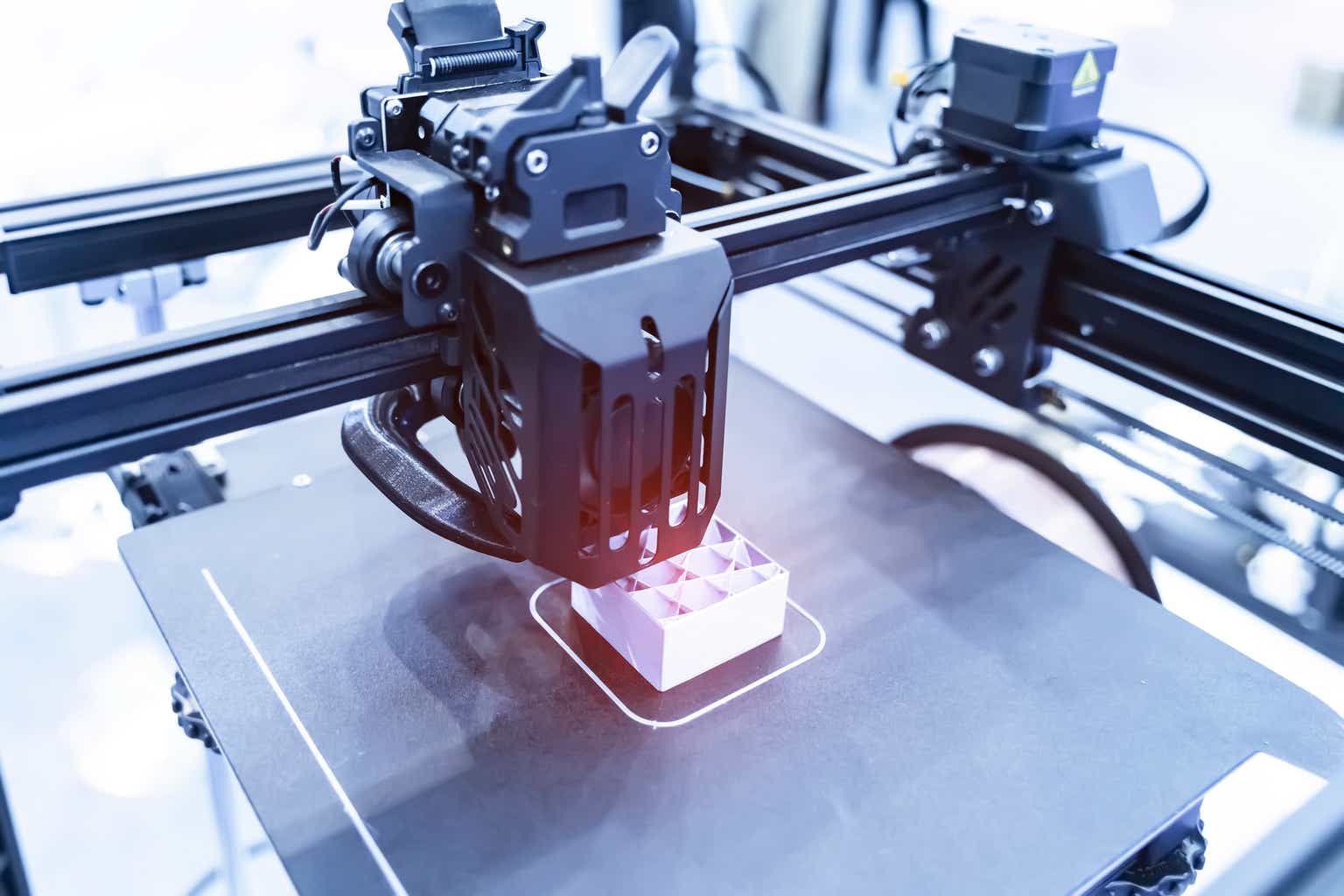Metal additive manufacturing technology company, Velo3D, Inc. (NYSE:VLD) reported Q2 2023 revenues of $25.13 million an increase of 27.95% (YoY) that missed estimates by $2.09 million. VLD’s EPS of -$0.10 also missed Wall Street estimates by $0.02. The stock has lost 10.86% (YTD) and is trading 67.5% below its 52-week high of $4.80 which to me is an attractive buy point.
Thesis
Velo3D has expanded its customer footprint from the space vertical to also include contract manufacturing, defense, aviation, and energy among other markets. I believe the company is encouraging the robust embracing of metal additive manufacturing to achieve the double goal of increased revenue and volume production to grow shareholder value.
In retrospect, additive manufacturing is the addition of materials in the case of Velo3D, metallic applications to create a 3-dimensional object. This manufacturing has been a critical aspect in the development of aerospace launch/ propulsion components. More than half of Velo3D’s US clients are in aerospace and the rest are manufacturers and suppliers.
Quarter Rreview
As earlier noted, Velo3D’s Q2 2023 revenue of $25 million was up 28% (YoY) and it was followed by a record gross profit of $3.0 million. The company has been increasing its market share in the 3D printing space ever since it went public in September 2021. In its Q2 2023 earnings report, the company stated that its printer margins were up 400 basis points to 15%. The 20% decline in bookings to $16 million from $20 million in Q1 2023 was offset by a record increase in new customer orders that accounted for up to 90% of the company’s bookings revenue in the quarter.
In my view, VLD is still in its infancy but its fundamentals are impressive and powered by competent management. It also ended the quarter with a backlog of $15 million supporting a revenue guidance of $25 million to $29 million in Q3 2023. This is important to consider as it already represents at least 60% of the revenue expected in the third quarter on the lower side.
Product and customer portfolio expansion
Velo3D’s AM solutions include “flow-print preparation software, the Sapphire family of metal 3D printers, Assure real-time quality validation and control software- that is enabled by its Intelligent Fusion underlying manufacturing process.” Through innovative 3D metal printing, VLD manufactures these high-end parts for use in among other cases spacecraft and rocket engines.
With a market cap of $306.93 million, VLD has been linked to notable companies such as Elon Musk’s SpaceX. While it was unable to acquire VLD before it went public, SpaceX now uses VLD’s technology for its raptor engineers. Back in June 2023, Velo3D announced that Italian aerospace firm, Avio S.p.A purchased two metal 3D printers namely the “Sapphire XC 1MZ printer and an original Sapphire printer to support the development and production of its propulsion systems and accelerate the advancement of the space industry.”
In its Q2 2023 earnings, VLD indicated that it was expanding its gross margin with sequential improvements expected into 2024. The company is looking at lower material costs to support this move and a surge in overall volume. More customers are choosing the Sapphire printers for their metal additive manufacturing needs.
In VLD’s deal with Avio, the company stated that the “Sapphire XC 1MZ printer had the largest build volumes for laser powder bed fusion 3D printers. It has a print volume of 600mm (diameter) and 1000 mm in height.” This deal will put VLD in the European market since Avio (through its Vega rocket family) leads in manufacturing military and space rocket motors in Italy.
VLD expects to execute its contracts and make prompt deliveries aided by a decrease in material costs. The result here is an increase in production volume by Q4 2023 that will generally improve the absorption of fixed costs spread over various units. This strategy will help the company achieve its long-term aim of making customer purchases to account for at least 50% of its revenue.
Market expansion
VLD intends to expand its customer footprint from the overdependence on the space vertical to other applications such as contract manufacturing, defense, energy, and aviation among others. The space vertical remains a key market for the company having added Avio and NASA into the customer mix in H1 2023. It is also true that most of these space companies have leveraged VLD’s designs over the years. Still, there is a stronger chance to grow in segments such as contract manufacturing which the company explained had gained up to 200 parts customers into H2 2023. Since September 2022, Velo3D has added among others StarHagen and Visser Precision (a parts maker for space and defense contractors) to its global network of contract manufacturers. The US Department of Defense has underscored the need for “developing advanced material science and technology” to use them as defense systems.
Additionally, I believe that we are soon entering the age of hypersonic flight vehicles, an aspect that has been long considered science fiction. The essence of 3D printing, according to me, is to bring such designs (technological breakthroughs) into reality and the development of propulsion devices capable of attaining hypersonic speeds is a clear goal.
What will make this advancement a reality?
Data availability in the current global setting is an added advantage to the advancement of 3D printing. What’s more, the advancement in the architecture of computational hardware and networks are power blocks for machine learning and artificial intelligence (AI). These aspects are key, especially in the establishment of prefabrication designs, detection of defects, and quality assurance.
Another position to consider is the fact that industrial companies post-Covid19 established cost-cutting measures such as importing or outsourcing parts and assembling rather than creating them on site. In the same way, VLD’s AM components are outsourced by other industries for fabrication. A look into the future shows that the company should invest in semiconductors that are considered highly competitive products to improve its capacity.
Financial strength
Velo3D announced a $70 million registered direct offering in Q2 2023 that will be used as liquidity to cover its long manufacturing lead times. This financing would also be used to augment customer and supplier confidence to improve overall business performance. Further, VLD’s total cash and short-term investments stood at $47.3 million in Q2 2023, a 26.09% (QoQ) decline from $64 million reported in Q1 2023.
The company’s revenue guidance for the Fiscal Year 2023 was reduced to the range of $105 million to $115 million from its Q1 2023 position of $120 million to $130 million. While considering this decrease, it is vital to understand that VLD’s revenue since FY 2020 has been steadily increasing. It stood at $19 million in 2020, then rose to $27.4 million in 2021 and $80.8 million in 2022. It is projected to rise by at least 29.95% (YoY).
In the 12 months trailing to June 2023, VLD used up $113.9 million in cash from operations. This was partially offset by a cash generation of $67.4 million from CapEx and an additional $31.9 million from financing activities. Also, VLD’s management has controlled its debt at $35.8 million which is lower than its current cash position of $47.3 million.
Risks and valuation
VLD’s business at the moment is located in a niche (aerospace) market with relatively few customers prominent of which is SpaceX. However, with the likes of NASA coming on board, VLD will become an attractive play in the future. I believe that they have a nice revolutionary product and they will need to continue expanding their contract manufacturing network for survival. It will also be important to embrace volume production for their Sapphire printers to increase sales. Scaling will be a challenge if the contract manufacturers will also be able to print the complex designs for customers similar to VLD and divest customers.
In regard to valuation, VLD’s price to sales (TTM) stands at 2.91 against the industry average of 1.30 (a difference of 122.93%). It is trading at least twice the sales. We may see further downside of the stock if the company’s business does not pick up. Although slightly overvalued, we may see future upside of the stock especially if they can lower their manufacturing lead times and improve inventory numbers. With aviation companies such as Boeing, Airbus, and even NASA using 3D printing technology, it may not be a surprise if VLD soon announces an acquisition.
Bottom line
I believe VLD is a long-term hold considering it manufactures mission-critical 3D printing solutions for aerospace companies. The company’s expansion of its contract manufacturing network is another step that will see it grasp markets outside the US. However, it will need to overcome its manufacturing challenges that have increased delivery lead times leading to a huge backlog of orders extending into H2 2023.
Read the full article here









Leave a Reply